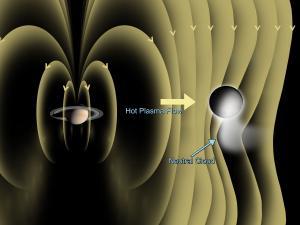Press Release: Magnetometer instrument confirms Enceladus' atmosphere

The Cassini Magnetometer team, using data from the very close flyby on July 15, have confirmed the atmosphere first seen during the two earlier flybys in February and March. Based largely on the MAG data obtained during those flybys, the altitude of the July flyby was lowered from 1000 km to a scant 175 km. With this new data in hand, and with improved modeling of the earlier data, the MAG team was also better able to constrain the nature of the atmosphere. Rather than a uniform atmosphere across the surface of Enceladus, the Magnetometer results are most consistent with a neutral cloud of gas concentrated over the south polar region of Enceladus. ISS images of the region showed a very young surface with numerous tectonic fractures and strange "chunky peanut butter-like" terrain. Away from the south polar region, the atmosphere is much thinner. These results indicate that Enceladus' atmosphere is similar to that of Io's, where point sources, in Io's case volcanoes, pump gases into space which then spreads out across the surface or escapes the satellite's gravitational pull entirely. This leads to significant differences in atmospheric density across the surface. The press release compared the concentration to that of a cometary jet, though there is no evidence that it needs to be THAT concentrated of a source. Perhaps there are several sources spread out over a similar area (20 degree half-width).
The press release also mentions that other Cassini instruments found an atmosphere at Enceladus, though it didn't go into specifics. UVIS had a stellar occultation at closest approach designed to look for the atmosphere and other fields-and-particles instruments, like INMS, were on during the encounter.


0 Comments:
Post a Comment
<< Home